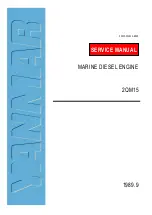
3. For adjustable carburetors, turn the carburetor IDLE JET in
(clockwise) until it just bottoms. DO NOT FORCE. Then, back
the IDLE JET out (counterclockwise) about 1-1/2 turns (see
Figure 3.5).
4. Turn the MAIN JET (Figure 3.5) in (clockwise) until it just
bottoms. DO NOT FORCE. Then, back the MAIN JET out
(counterclockwise) about 1-1/2 turns.
RUNNING ADJUSTMENT:
After completing the INITIAL ADJUSTMENT, final adjustment can
be accomplished with the engine running. Proceed as follows:
NOTE: For AC generator applications, disconnect or
turn OFF all electrical loads. For nongenerator applica-
tions, turn OFF the equipment being powered. Initial
checks and adjustments will be accomplished with
engine at no-load.
1. If so equipped, set the idle control switch to OFF.
2. Start the engine, let it warm up and stabilize at no-load.
3. For AC generator applications, connect an AC frequency
meter to one of the generator's AC output receptacles.
a. If the generator is rated 60 Hertz, the no-load AC fre-
quency reading should be 61.5-63.5 Hertz.
b. If the generator is rated 50 Hertz, the no-load AC fre-
quency should be 50.5-51.5 Hertz.
4. For non-generator applications (pumps, pressure washers,
etc.), refer to the product DATA PLATE for rated engine
speed. Use a tachometer to read engine speed.
NOTE: Several types of inexpensive tachometers are
commercially available.
5. If the frequency (or rpm) reading is incorrect, turn the
SPEED ADJUST NUT (Figure 3.3) on the governor until fre-
quency or rpm is within limits.
6. If frequency or rpm is unstable, turn the IDLE SPEED SCREW
on carburetor until engine stabilizes.
DO NOT TURN THE
IDLE SPEED SCREW IN FURTHER THAN NECESSARY
. Fine
tune this adjustment after the engine has warmed up and
stabilized. Adjust it 1/8 turn at a time.
7. When the no-load frequency or rpm is correct, apply a load
to the engine.
a. For AC generator applications, connect electrical loads
as close as possible to the unit's rated wattages/amper-
age capacity.
b. For nongenerator applications, turn on the equipment
being powered by the engine.
8. With a load applied to the engine, adjust the carburetor
as follows:
a. CARBURETOR WITH FIXED MAIN JET: Slowly adjust the
IDLE SPEED SCREW to obtain best operation and high-
est rpm under load (see Figure 3.6). DO NOT EXCEED
RPM SPECIFICATION.
b. CARBURETOR WITH ADJUSTABLE MAIN JET: Adjust the
carburetor as follows:
(1) Slowly turn the MAIN JET counterclockwise ( richer)
until rpm or frequency starts to drop off.
(2) Turn the MAIN JET clockwise (leaner) until rpm or fre-
quency again starts to decrease.
(3) Turn the MAIN JET counterclockwise (richer) until the
best and most stable frequency or rpm is obtained.
9. Turn off all loads and check the no-load governor setting.
Readjust governor no-load speed, if necessary.
Figure 3.5 — Adjustable Carburetor
Figure 3.6 — Carburetor Adjustment (Typical)
20
SECTION 3: MECHANICAL GOVERNOR
GENER
A
C
Содержание GN190H
Страница 1: ......
Страница 6: ...4 DIMENSIONS AND FEATURES G E N E R A C PTO SIDE VIEW BOTTOM VIEW MOUNTING HOLES...
Страница 7: ...5 DIMENSIONS AND FEATURES FRONT VIEW...
Страница 8: ...6 DIMENSIONS AND FEATURES G E N E R A C STARTER SIDE VIEW PTO CRANKSHAFT OPTIONS VIEW...
Страница 15: ...13 NOTES...
Страница 23: ...21 NOTES...
Страница 39: ...NOTES 37...
Страница 62: ...Printed in U S A Copyright 1999 Generac Power Systems Inc...
















































